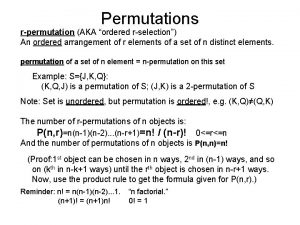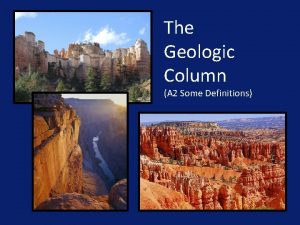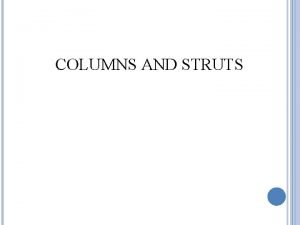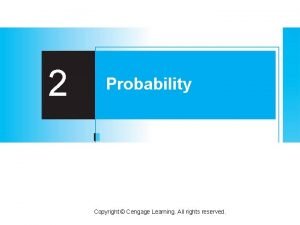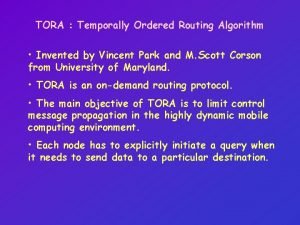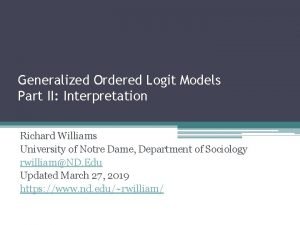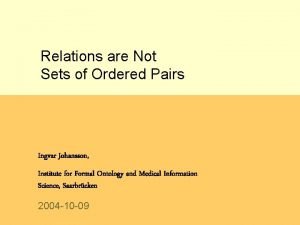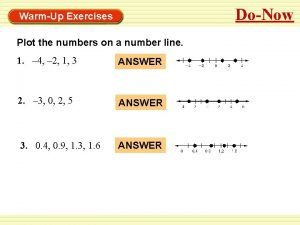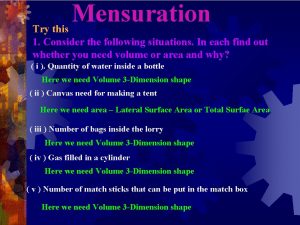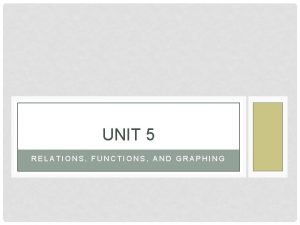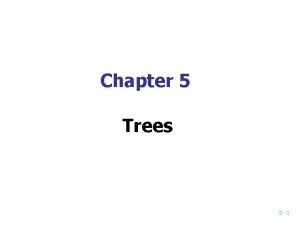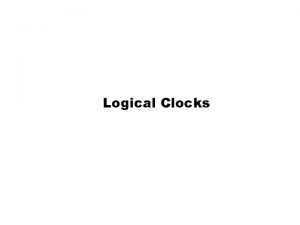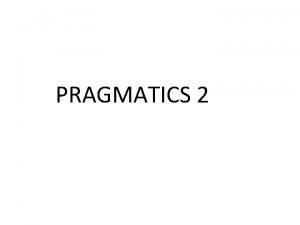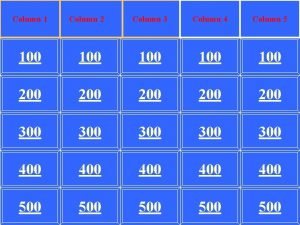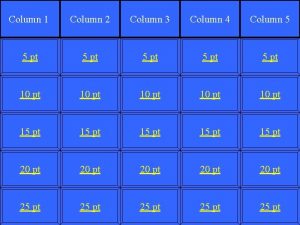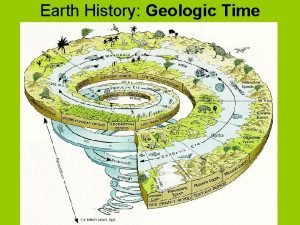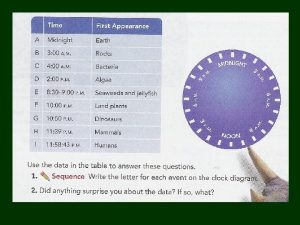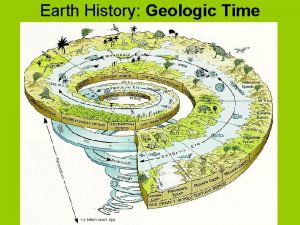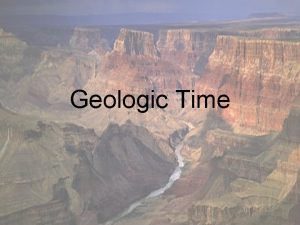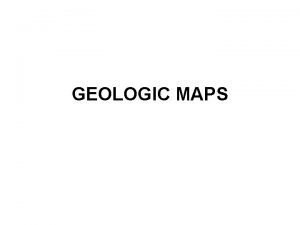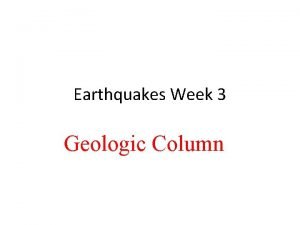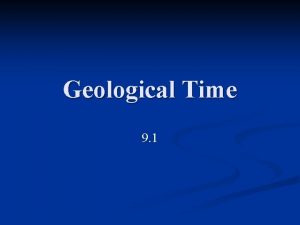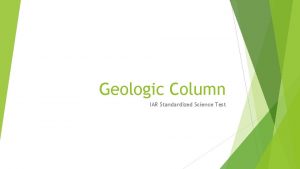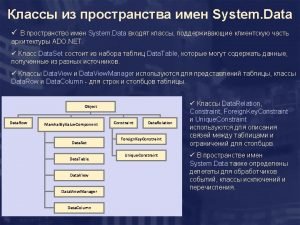The Geologic Column Geologic column an ordered arrangement
























- Slides: 24


The Geologic Column • Geologic column – an ordered arrangement of rock layers that is based on the relative ages of the rocks; the oldest rocks are at the bottom. • A geologic column represents a timeline of Earth’s history. The types of rocks in each layer and the kinds of fossils in each layer tell us the story about what was happening when that layer was being created. o Think about this! At one time, each layer was a former surface!


Geologic Time Vocab • Eon –the largest unit of geologic time. Divided into 4 eons: Hadean, Archean, Proterozoic, Phanerozoic. • Precambrian time – consists of Hadean, Archean, and Proterozoic. This 4 billion year time interval contains most of Earth’s history. We have very few fossils from this time so it is difficult to divide this time interval into smaller units.

Geologic Time Vocab • Era – a unit of geologic time that includes two or more periods (Cenozoic, Mesozoic, Paleozoic) • Period – a unit of geologic time that is longer that an epoch, but shorter than an era (Quaternary, Tertiary, Cretaceous, Jurassic, Triassic, Permian, Carboniferous, Devonian, Silurian, Ordovician, Cambrian) • Epoch – a subdivision of geologic time that is longer than an age but shorter than a period (Holocene, Pleistocene, Pliocene, Miocene, Oligocene, Eocene, Paleocene, Pennsylvanian period, Mississippian Period) • Age – ages are defined by distinct fossils in the fossil record. Confusing, right? Let’s put this together.

Geologic Time Map • • Group 1 – Eons (some classes will also do Cenozoic characteristics) Group 2 – Eras (Mesozoic characteristics) Group 3 – Periods (Paleozoic characteristics) Group 4 – Epochs Group 5 – Cenozoic Characteristics Group 6 – Mesozoic Characteristics Group 7 – Paleozoic Characteristics

Geologic Time Analysis • • • In what eras do we find mass extinctions? In what epoch do we find the appearance of humans? When do the first vertebrates appear? What period do you think was important for the development of coal? If I had a time machine, to what PERIOD would I travel to see a Tyrannosaurus Rex?

Precambrian Time • Earth formed roughly 4. 6 billion years ago from a nebula (a cloud of dust and gas). Precambrian time is a geologic time interval that spans from the formation of Earth to 542 million years ago. o This time span makes up 88% of Earth’s history, and we know very little about it. • Of the few fossils we have, stromatolites have been discovered. This algae forms today in warm, shallow waters. What does this say about early Earth?

The Paleozoic Era • This era began roughly 542 million years ago (ma). At the beginning of this era the continents were spread around the world. By the time the era ended 251 ma, the continents had collided into the supercontinent known as Pangea. • We have a wonderful fossil record from this time, so we are able to divide it into six periods.

Spider Map of the Paleozoic Era • For each period provide the following information: o Key Species o Characteristics of environment and climate o Any important events • What patterns do you notice?

Journal Article Analysis • Identify any difficult words by highlighting those words. Try to define them based on their context. Look up the words. • Identify vocabulary words by underlining them. • Write a short summary of the article.

Mesozoic • The Mesozoic Era began roughly 251 (ma) and ended 65 ma. Earth’s surface changed dramatically. Pangaea broke into smaller continents, and the collision of the plates led to the creation of mountains. • Shallow seas and marshes covered most of the land the climate was warm and humid. The climate favored reptiles. • The era is known as the “Age of Reptiles”. We have a rich fossil record and the era is divided into three periods.

The Triassic Period • Dinosaurs appeared during the Triassic period. Of course, some dinosaurs were only the size of squirrels, but some weighed as much as 15 tons. Most dinosaurs were only 4 -5 meters long and moved quickly. The land was covered by lush conifer forests. The oceans were full of marine invertebrates such as the ammonite. • The first mammals appeared. These were small rodent-like forest dwellers. • 248 -206 mya • Hot and dry environment

Jurassic Period • Dinosaurs became the dominant life form during this period. Fossils indicate two major groups of dinosaurs evolved: o Saurischians, or “lizard hipped” o Ornithischians, or “bird hipped” • Flying reptiles called pterosaurs also became common • 206 -144 mya • Lush, warm environment.

Saurischians, or “lizard hipped”

Ornithischians, or “bird hipped”

The Cretaceous Period • • • Dinosaurs continue to dominate Earth. 144 -65 mya Swampy, warm climate Tyrannosaurus Rex appears during this time! Plant life had become very sophisticated during this time. Angiosperms, or flowering plants appear, which include trees like magnolias and willows. Later, maples, oaks, and walnuts become abundant. Angiosperms were so successful they are the dominate type of land plant today!

The Cretaceous Mass Extinction • No dinosaur fossils have been found in rock dated later than the Cretaceous period. Scientists have not agreed 100% on what caused this extinction. Some scientists think changes in the environment due to volcanic activity may have caused the extinction. • Other scientists argue that Earth was hit by giant meteorite. This impact created so much dust that the sun’s rays were blocked, which effectively changed Earth’s climate. This hypothesis is supported by the presence of iridium in Cretaceous period rock. This substance is not common on Earth, but is common in meteorites.

Whoa.

The Cenozoic Era • The Cenozoic is the division of geological time that began about 65 million ya and includes the present period. The Cenozoic is divided into two periods. o Quaternary – made up of the Pleistocene and Holocene Epochs o Tertiary – made up of the Paleocene, Eocene, Oligocene, Miocene, Pliocene Epochs.

The Tertiary Period • Paleocene – began roughly 65. 5 mya, many new mammals evolved. The first primates also evolved during this time. • Eocene – began roughly 60 mya. The earliest known ancestor of the horse appeared during this time. Fossil records indicate that the first whales, flying squirrels, and bats evolved. Worldwide temperatures dropped by about 4 degrees C by the end of the Eocene.

Tertiary Period • Oligocene – the Indian subcontinent began to collide with the Eurasian continent which eventually forms the Himalayas. The climate became significantly cooler and drier and this change favored grasses and conebearing and hardwood trees. • Many early mammals became extinct; however, large species such as deer, pigs, horses, etc. flourished.

Tertiary Period • Miocene – the modern Antarctic icecap began to form. The earliest human ancestors are dated to this epoch. • Pliocene – predators – bear, dog, cat – evolved into modern forms. Dramatic climate changes occurred towards the end of the Pliocene. The continental ice sheets spread and sea levels dropped. The Bering land bridge was exposed and continental uplift created the Central American land bridge between North and South America. This meant animals could migrate great distances.

The Quaternary Period • The Pleistocene Epoch began 1. 8 million years ago. Fossils of the earliest modern humans (Homo sapiens) were discovered in the Pleistocene sediments. Examples of cave art in present day France indicate that early Homo sapiens were hunters. • The Holocene Epoch began around 11, 500 years ago and is the current epoch (i. e. we are living in the Holocene). The glacial period ended and the ice sheets melted, which resulted in raised sea levels.
 Compare geologic time with the geologic column.
Compare geologic time with the geologic column. Ordered arrangement
Ordered arrangement An ordered arrangement
An ordered arrangement Geologic column definition
Geologic column definition Slenderness ratio buckling
Slenderness ratio buckling Who ordered the parthenon to be built
Who ordered the parthenon to be built How to find domain and range
How to find domain and range Product rule for ordered pairs
Product rule for ordered pairs Tora algorithm
Tora algorithm Ordered pairs
Ordered pairs Interpretation of linear probability model
Interpretation of linear probability model Set of ordered pairs
Set of ordered pairs An ordered life
An ordered life This area along the german/belgian border was demilitarized
This area along the german/belgian border was demilitarized A sequence is a list of ordered pairs.
A sequence is a list of ordered pairs. Which ordered pair is a solution of the equation
Which ordered pair is a solution of the equation Ordered matrix
Ordered matrix A sports company was ordered to prepare 100 paper cylinders
A sports company was ordered to prepare 100 paper cylinders Ordered pairs that represent a function examples
Ordered pairs that represent a function examples Binary tree descendants
Binary tree descendants Based on the ordered pairs in the data below
Based on the ordered pairs in the data below Totally ordered multicast
Totally ordered multicast Background and foreground entailment
Background and foreground entailment Queue/ antraian = ordered list
Queue/ antraian = ordered list Ordered broadcast
Ordered broadcast

